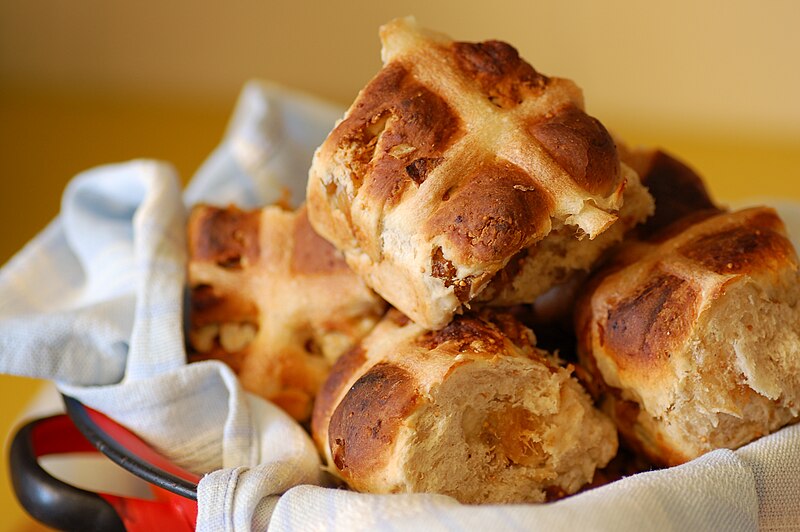Back in 1592, the clerk of the London Markets decreed that there were just three days when hot cross buns could be eaten – Good Friday, Christmas Day and at funerals. Punishment for breaking the rule was the confiscation of the offending buns, which would then be given to the poor. After this, buns were generally baked at home. Now, we can occasionally find proper buns at an old-fashioned bakery. The mass-produced, supermarket variety have a tendency to be disappointing and often light on spice and fruit.
The buns seem to have originated in pagan times, for the festival of Eostre or Ostara, honouring the goddess Ostara. A spiced bread was then made. Early Christians adapted the festival and the bread, adding a cross to it. The spices are said to represent those with which Christ was embalmed.
In England there is a tradition that buns were made by Brother Thomas Rodcliffe at St Alban’s abbey. Called Alban buns, they were given to the poor from about 1361.
The first recorded reference to the hot cross bun came in a song from 1733, which was printed in Poor Robin’s Almanac. Its lyrics included, “Good Friday comes this month, the old woman runs, with one a penny, two a penny, hot cross buns.”
As with many items, there are traditions relating to the buns. A bun baked on Good Friday will, apparently, be fresh the following year. A bite from such a bun will cure illness (or cause illness?). If a ship has a Good Friday bun on board it won’t sink. The Titanic sailed just after Easter 1912. If only they had taken a Good Friday bun! A piece of a Good Friday bun hanging in your kitchen will protect your house from fire (but see below) and ensure that you bake perfect bread.
There is a sad bun story, connected with the Widow’s Son pub in Bow, London, in the 1840s, on the site of an older house. In that house lived a widow, with a son fighting against Napoleon during the early years of the 19th century. He wrote saying that he would be home for Easter, but died at sea on the way. In readiness his mother baked a batch of hot cross buns. His death broke her heart, and she saved the buns meant for him, and hung them from the ceiling in a bag. She added a new bun every year. That tradition is still carried on, with a Royal Navy sailor adding a new bun each year. Sadly, there was a fire in the 1980s, but the charred bun remains were saved, and the annual bun is added to them.
Buns are no longer one a penny, two a penny. It’s more likely to be £1.50 for four at the supermarket.
Image Credits: Jules/Wikimedia Commons https://commons.wikimedia.org/wiki/File:Hot_cross_buns_-_fig_and_pecan.jpg https://creativecommons.org/licenses/by/2.0/deed.en .



